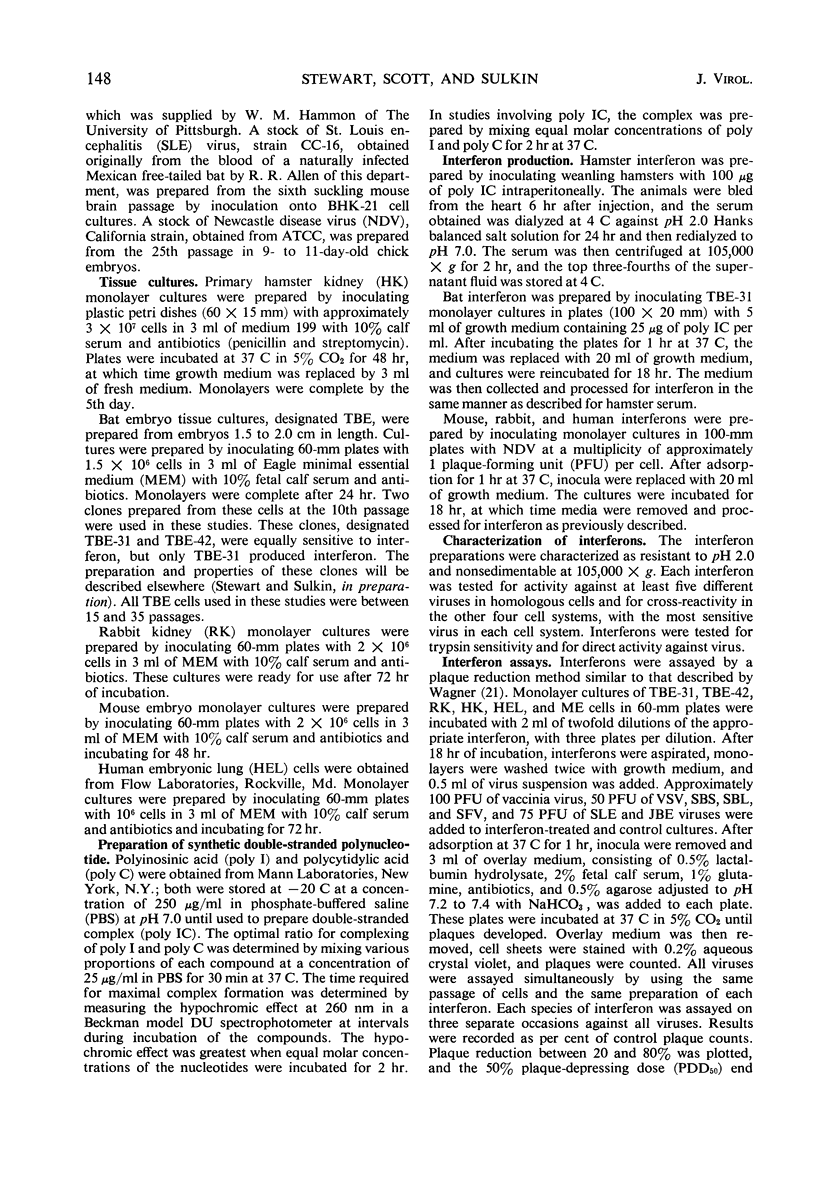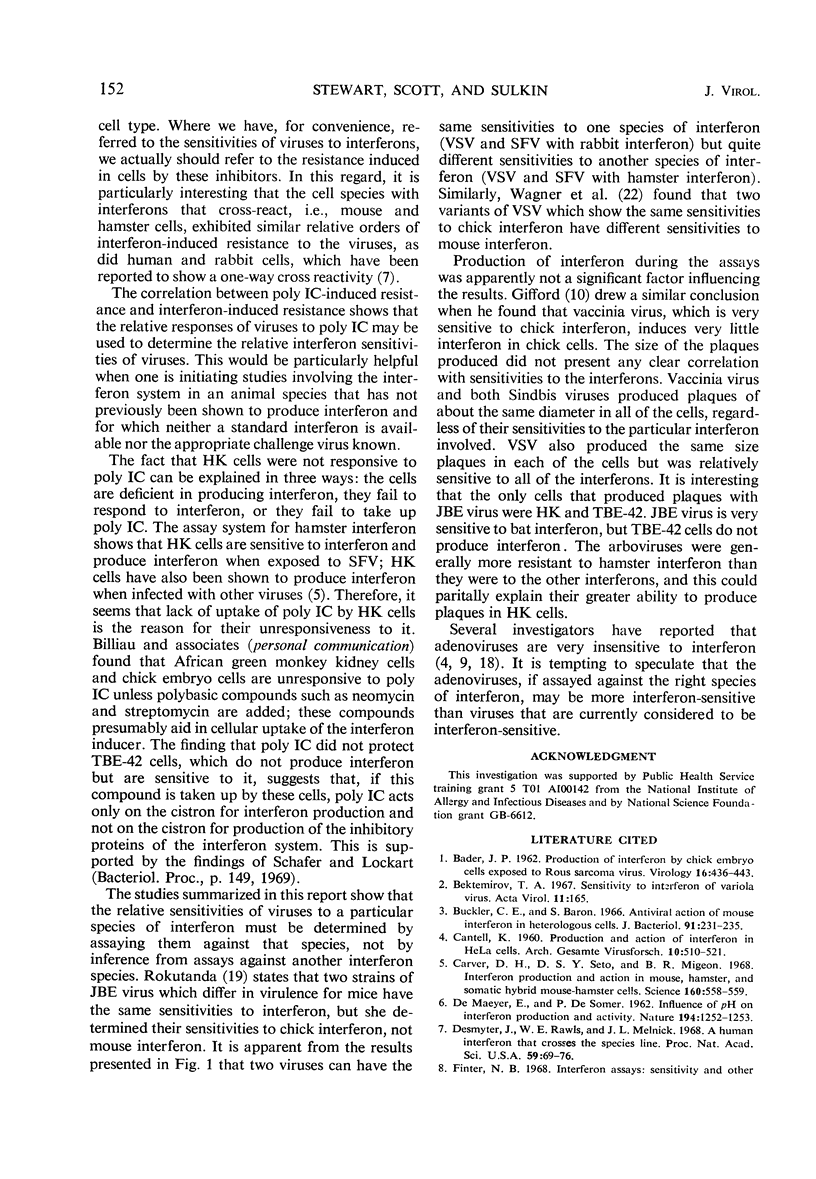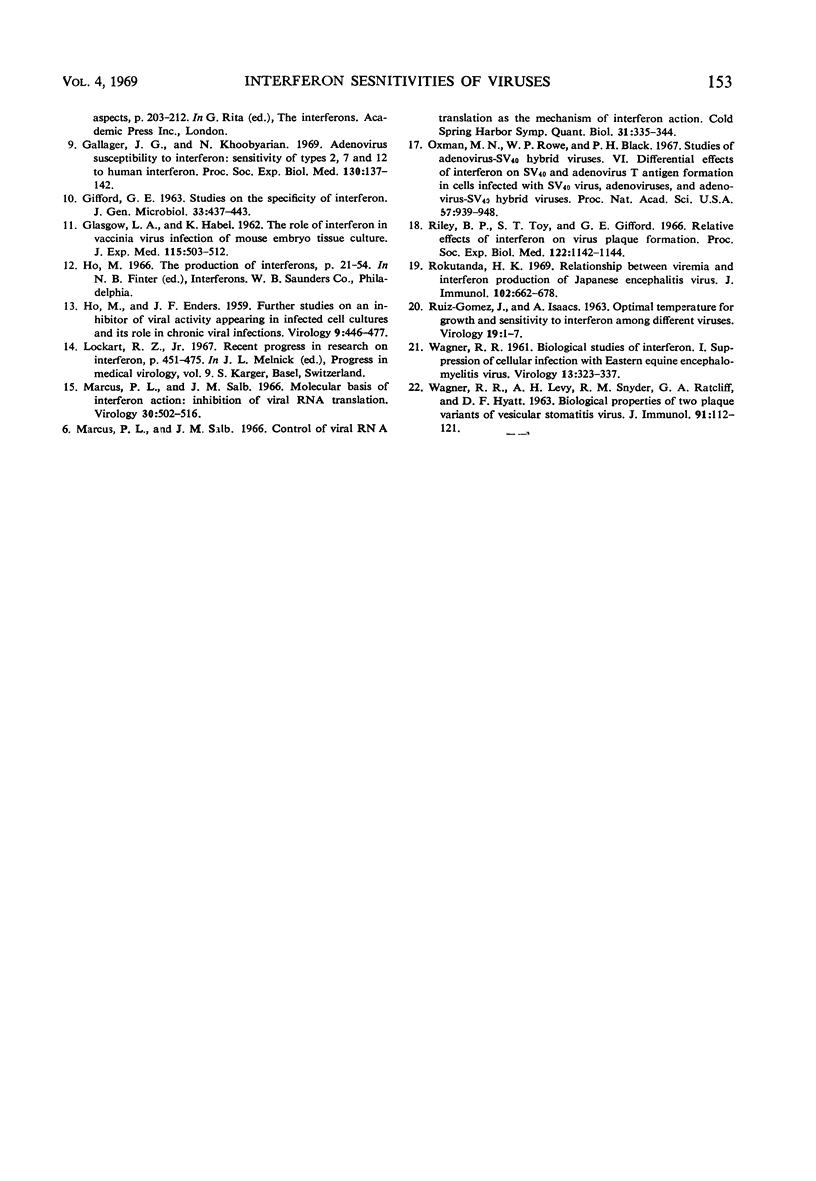Abstract
Some viruses were found to be more sensitive than others to the action of interferons from certain species of animals but less sensitive to interferons from other species. Vaccinia virus was the most sensitive to mouse and hamster interferons of five viruses tested, but the least sensitive of these five viruses to human, rabbit, and bat interferons. The relative sensitivities of the viruses to interferons were found to be characteristic for each of the species tested, with those closely related phylogenetically exhibiting similar patterns of relative interferon-induced virus resistance. The amount of synthetic double-stranded polynucleotide polyinosinic acid-polycytidylic acid required to induce resistance to each of the viruses in each of the cell species correlated with the interferon sensitivities of the viruses.
Full text
PDF






Selected References
These references are in PubMed. This may not be the complete list of references from this article.
- BADER J. P. Production of interferon by chick embryo cells exposed to Rous sarcoma virus. Virology. 1962 Apr;16:436–443. doi: 10.1016/0042-6822(62)90224-6. [DOI] [PubMed] [Google Scholar]
- Buckler C. E., Baron S. Antiviral action of mouse interferon in heterologous cells. J Bacteriol. 1966 Jan;91(1):231–235. doi: 10.1128/jb.91.1.231-235.1966. [DOI] [PMC free article] [PubMed] [Google Scholar]
- CANTELL K. Production and action of interferon in HeLa cells. Arch Gesamte Virusforsch. 1961;10:510–521. doi: 10.1007/BF01241887. [DOI] [PubMed] [Google Scholar]
- Carver D. H., Seto D. S., Migeon B. R. Interferon production and action in mouse, hamster and somatic hybrid mouse-hamster cells. Science. 1968 May 3;160(3827):558–559. doi: 10.1126/science.160.3827.558. [DOI] [PubMed] [Google Scholar]
- Desmyter J., Rawls W. E., Melnick J. L. A human interferon that crosses the species line. Proc Natl Acad Sci U S A. 1968 Jan;59(1):69–76. doi: 10.1073/pnas.59.1.69. [DOI] [PMC free article] [PubMed] [Google Scholar]
- GIFFORD G. E. STUDIES ON THE SPECIFICITY OF INTERFERON. J Gen Microbiol. 1963 Dec;33:437–443. doi: 10.1099/00221287-33-3-437. [DOI] [PubMed] [Google Scholar]
- GLASGOW L. A., HABEL K. The role of interferon in vaccinia virus infection of mouse embryo tissue culture. J Exp Med. 1962 Mar 1;115:503–512. doi: 10.1084/jem.115.3.503. [DOI] [PMC free article] [PubMed] [Google Scholar]
- Gallagher J. G., Khoobyarian N. Adenovirus susceptibility to interferon: sensitivity of types 2,7, and 12 to human interferon. Proc Soc Exp Biol Med. 1969 Jan;130(1):137–142. doi: 10.3181/00379727-130-33506. [DOI] [PubMed] [Google Scholar]
- HO M., ENDERS J. F. Further studies on an inhibitor of viral activity appearing in infected cell cultures and its role in chronic viral infections. Virology. 1959 Nov;9:446–477. doi: 10.1016/0042-6822(59)90135-7. [DOI] [PubMed] [Google Scholar]
- Lockart R. Z., Jr Recent progress in research on interferons. Prog Med Virol. 1967;9:451–475. [PubMed] [Google Scholar]
- Marcus P. I., Salb J. M. Molecular basis of interferon action: inhibition of viral RNA translation. Virology. 1966 Nov;30(3):502–516. doi: 10.1016/0042-6822(66)90126-7. [DOI] [PubMed] [Google Scholar]
- Oxman M. N., Rowe W. P., Black P. H. Studies of adenovirus-SV40 hybrid viruses, VI. Differential effects of interferon on SV40 and adenovirus T antigen formation in cells infected with SV40 virus, adenoviruses, and adenovirus-SV40 hybrid viruses. Proc Natl Acad Sci U S A. 1967 Apr;57(4):941–948. doi: 10.1073/pnas.57.4.941. [DOI] [PMC free article] [PubMed] [Google Scholar]
- RUIZ-GOMEZ J., ISAACS A. Optimal temperature for growth and sensitivity to interferon among different viruses. Virology. 1963 Jan;19:1–7. doi: 10.1016/0042-6822(63)90017-5. [DOI] [PubMed] [Google Scholar]
- Riley B. P., Toy S. T., Gifford G. E. Relative effects of interferon on virus plaque formation. Proc Soc Exp Biol Med. 1966 Aug-Sep;122(4):1142–1144. doi: 10.3181/00379727-122-31346. [DOI] [PubMed] [Google Scholar]
- Rokutanda H. K. Relationship between viremia and interferon production of Japanese encephalitis virus. J Immunol. 1969 Mar;102(3):662–670. [PubMed] [Google Scholar]
- WAGNER R. R. Biological studies of interferon. I. Suppression of cellular infection with eastern equine encephalomyelitis virus. Virology. 1961 Mar;13:323–337. doi: 10.1016/0042-6822(61)90152-0. [DOI] [PubMed] [Google Scholar]
- WAGNER R. R., LEVEY A. H., SNYDER R. M., RATCLIFF G. A., Jr, HYATT D. F. BIOLOGIC PROPERTIES OF TWO PLAQUE VARIANTS OF VESICULAR STOMATITIS VIRUS (INDIANA SEROTYPE). J Immunol. 1963 Jul;91:112–122. [PubMed] [Google Scholar]


